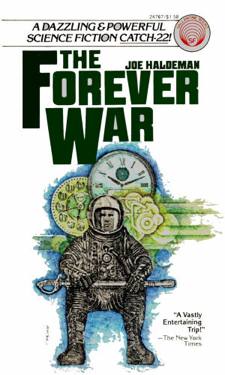The cliché thing to say about Joe Haldeman’s The Forever War (1974) is that it’s about Vietnam, but of course it isn’t. It does reflect Haldeman’s own experiences of being conscripted and being sent to Vietnam, of course, and it’s a better book for it, but what it’s about is how society changes over time, and how relativity can let one man see a long long chunk of time while not growing very much older. The war, the alien enemy Taurans, the army bureaucracy and the battles are all devices to get our viewpoint character William Mandella skipping across time and touching down briefly in a world grown ever stranger. What brings me back to it is Mandella’s engaging first person voice and Haldeman’s powers of sociological extrapolation. You’re getting a whole pile of worlds for the price of one here. It’s like those stories where somebody from the present finds themselves in the future—except that Mandella keeps on finding himself in the future again and again and again.
Wishy-washy spoilers, no real spoilers.
William Mandella is an American, born at about the time the story was written. He was conscripted in the Elite Conscription Act, which conscripted the fittest and the brightest—he already had his masters in physics. The story begins in the late nineties with his military training. This isn’t the late nineties as we knew them, this is the late nineties as extrapolated from 1974. Everyone smokes dope, and sexual equality in the military has led to mixed gender strike forces with random mixed-gender bunk assignments. Mandella, after a hard day’s training sighs “Why do you always get the tired ones when you’re ready and the randy ones when you’re sleepy?” Humanity is at war with aliens and has relativistic space travel with the aid of collapsars. Part of training is building a base on Charon in armour suits. But this isn’t very different from our world and we recognise Mandella as a very familiar viewpoint.
The shape of the book is that he goes out, and we get to see how the army is doing, and then he comes back and, as time has passed relativistically, we get to see how Earth is doing—and later, all of humanity including colonized planets. Everything changes, the only constants are Mandella himself and the war. In each section we are shown telling details and see Mandella overcome challenges.
The war is well written and well explained. There are battles with aliens, and they are interesting extrapolations of technology and far more realistic than anything you normally see in MilSF, because the soldiers spend most of their time bored. This isn’t a book that glorifies the military—but it’s a book written by somebody who knows what it’s really like being a soldier, and being a conscript in a war he doesn’t entirely understand why they are fighting.
One of the nifty things Haldeman does is with homosexuality. In the original army everyone is assumed to be (and pretty much commanded to be) straight, with the sleeping assignments and so on. The first time Mandella comes back, about a third of people are homosexual, and Mandella says he has no prejudices but is horrified by make-up on men. The next time, almost everybody is and he’s the only heterosexual on the ship he’s commanding, and he’s nicknamed “Old Queer.” This is a small thing, but it was daring in 1974 and Haldeman deals with it well.
The one-third gay Earth is the one we get to see in the most detail—it’s 2007. Mandella’s mother is alive but old, his younger brother looks like his father, everyone is living in arcologies and most people are unemployed but fairly happily creating art. There are lunar bases, they are colonizing other planets and fighting an interstellar war with aliens, but computers are room-sized and supercooled. It’s not what happened, but it’s cool to see. The same goes for the other futures.
The book is also a relativistic love story. Marygay Potter isn’t a well developed character, but Mandella’s clear love for her comes through and makes that aspect of the book work. I don’t want to talk about it too much because that strikes me as the one thing that really would be a spoiler.
Mandella has a very engaging first person voice, which is what carries the book, he’s got that confident confiding tone that keeps you reading.
This was Haldeman’s first novel, it won the Hugo and the Nebula. He has gone on to have a solid career in SF, publishing lots of books and short stories and terrific poetry, winning awards, and last year he was made a Damon Knight Memorial Grand Master by SFWA.
Jo Walton is a science fiction and fantasy writer. She’s published two poetry collections and nine novels, most recently Among Others, and if you liked this post you will like it. She reads a lot, and blogs about it here regularly. She comes from Wales but lives in Montreal where the food and books are more varied.










